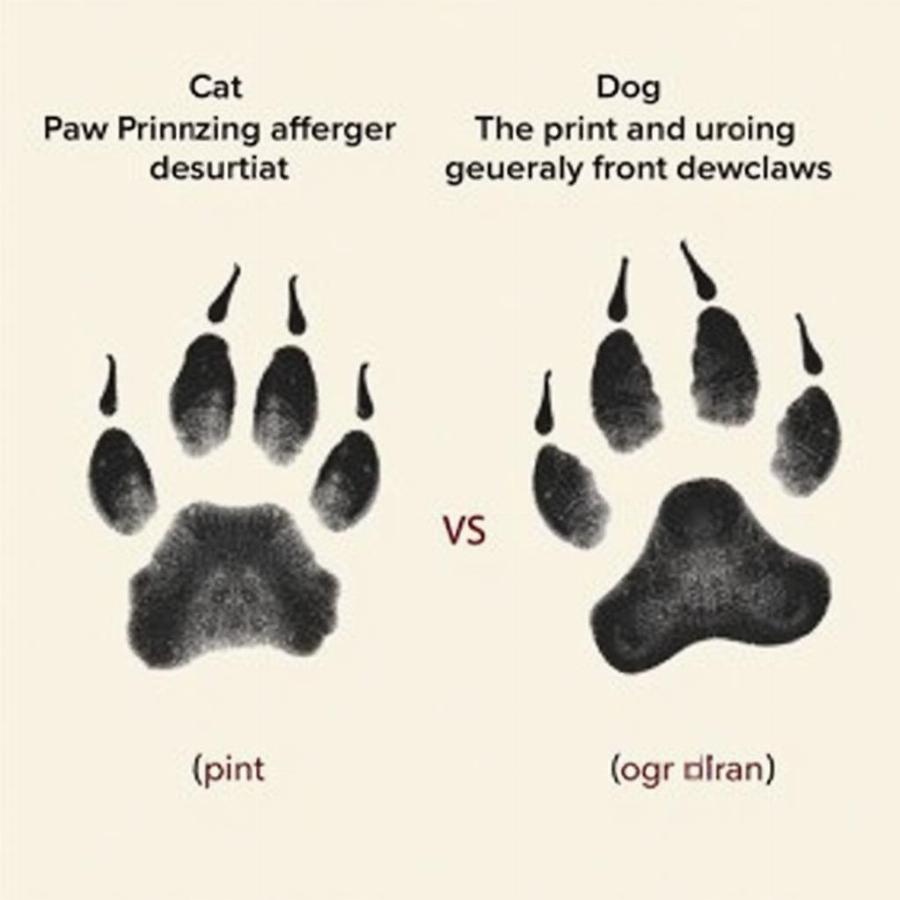Cat paws and dog paw prints, while both adorable, hold distinct differences that reveal fascinating insights into the unique anatomy and behavior of our beloved feline and canine companions. Understanding these differences can be surprisingly helpful, especially for pet owners keen on identifying tracks in their backyard or even understanding their pet’s movement and health.
Deciphering the Prints: Spotting the Differences
 Dấu chân mèo và chó: So sánh sự khác biệt
Dấu chân mèo và chó: So sánh sự khác biệt
While both cats and dogs walk on their toes (digitigrade locomotion), the shape and structure of their paws leave distinct marks. Cat paws, known for their stealth, typically register four toe prints in a rounded pattern, often without the visible mark of their front dewclaws (those little “thumbs” higher up on their leg). Dog paw prints, on the other hand, usually show the four toes and the prominent front dewclaw, resulting in a more oval-shaped print. This difference is due to the retractable nature of a cat’s claws, keeping them sharp and hidden until needed for climbing, hunting, or defending themselves. funny dog quote This unique feature makes their paws more compact and their prints tidier.
Paw Print Size: A Tale of Two Sizes
Size is another key differentiator. Naturally, larger dog breeds will have larger paw prints than smaller breeds. However, even a large cat’s paw print will rarely be as large as that of a medium-sized dog. The size disparity reflects the different builds and roles these animals have played throughout evolution. Dogs, often bred for work or hunting, tend to have larger, more robust paws for enduring longer distances and rougher terrain.
The Texture Tells a Story: Pad Shape and Detail
The pads on the paws also provide clues. Cat paw pads are generally smoother and more oval-shaped, while dog paw pads are often rougher and more triangular. dog paw stickers Examining the texture within the paw print can reveal further details about the animal’s environment and activity. For example, a muddy dog print might show more defined pad details than a print on a dry surface.
Why is this important for dog owners?
Understanding the nuances of dog paw prints, specifically, can help owners assess their dog’s gait and overall paw health. dog cut foot Irregular prints may indicate a limp or injury, prompting a visit to the vet. Furthermore, recognizing your dog’s unique paw print can be helpful in identifying your furry friend if they ever get lost.
How can I take a paw print of my dog?
Using non-toxic paint or ink, gently press your dog’s paw onto a piece of paper. Be patient and reward your dog for cooperating!
Do all dog paw prints look the same?
No, just like human fingerprints, each dog’s paw print is unique. real dog paw print However, the general shape and features remain consistent within the species.
Expert Insights
Dr. Emily Carter, a renowned veterinarian specializing in canine anatomy, highlights, “Observing your dog’s paw prints can offer valuable insights into their musculoskeletal health. Changes in the print pattern can be an early indicator of potential problems.”
Conclusion
Cat paws and dog paw prints tell a story about the unique characteristics of each species. While both are undeniably charming, their differences offer valuable clues about the animal’s anatomy, behavior, and even their health. By understanding these subtle differences, we can deepen our appreciation for our furry companions and better care for their well-being. Remember, paying attention to those little paw prints can make a big difference.
FAQ:
- Q: Can I identify my dog’s breed from its paw print?
A: Not definitively. While breed can influence paw size, it’s not a reliable identification method. - Q: What can unusual wear patterns on my dog’s paws indicate?
A: It could indicate gait issues, arthritis, or other underlying health problems. Consult your veterinarian. - Q: Are there any resources for learning more about animal tracking?
A: Yes, many field guides and online resources offer detailed information on animal track identification. - Q: Do cats always retract their claws?
A: Generally, yes. However, they may extend their claws when stretching, climbing, or feeling threatened. - Q: Why are my dog’s paw pads dry and cracked?
A: This can be caused by various factors, including weather conditions, allergies, or nutritional deficiencies. Consult your vet. - Q: How often should I check my dog’s paws?
A: Regularly, ideally daily. This allows you to catch any potential issues early. - Q: What can I do to protect my dog’s paws in extreme weather?
A: Use paw balm in winter to protect from salt and ice, and avoid hot pavement in summer.
Other Questions & Related Articles
You might also be interested in learning about dog foot bones.
Beaut Dogs
Beaut Dogs is your ultimate guide to the captivating world of dog breeds, offering a comprehensive resource for dog lovers and owners. We provide expert advice on everything from breed selection and care to training and health. When you need assistance, don’t hesitate to contact us via Email: [email protected] for detailed and accurate information from Beaut Dogs.